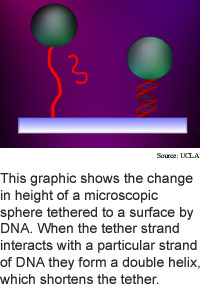
Detector senses single DNA
Double-stranded DNA forms the famous double-helix
shape. Keep a single strand of DNA separated from its other half, however,
and it coils like a loose ball of yarn. The single strand can also stretch
more than the double helix.
Researchers from the University of California at Los Angeles have
tapped these differences in shape to make a sensor capable of detecting
a single DNA molecule.
The device could eventually identify genetic markers for diseases
including cancer and changes in DNA left by diseases like leukemia, according
to the researchers. It could also be used to monitor small pools of cells
like those used in stem cell research and in testing the response of cells
to new drugs, according to the researchers.
The sensor consists of a micron-sized bead connected to a flat surface
by a single strand of DNA. The bead is repulsed by the surface and so pulls
the strand straight. When the DNA comes in contact with a DNA strand it
can combine with, the interaction shortens the tether by a few nanometers.
A micron is one thousandth of a millimeter; a nanometer is one thousandth
of a micron, or the span of ten hydrogen atoms. The device identifies this
change by sensing differences in the way the bead scatters light.
The method could be used to make hand-held DNA detectors in two
to three years, according to the researchers. The work appeared in the June
24, 2003 issue of the Proceedings of the National Academy of Sciences.
Software speeds modeling
DNA plays tic-tac-toe
Email updates six degrees theory
Cellophane turns LCDs 3D
News briefs:
Detector senses single DNA
Crystal shortens infrared waves
Tool sketches quantum circuits
Nanotubes spark gas detector
Metal process makes heat chips
Light makes molecule shine

Research Watch blog
View from the High Ground Q&A
How It Works
RSS Feeds:
News
Ad links:
Buy an ad link
Ad links: Clear History
Buy an ad link
|
TRN
Newswire and Headline Feeds for Web sites
|
© Copyright Technology Research News, LLC 2000-2010. All rights reserved.